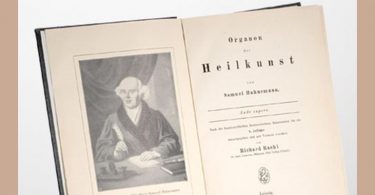You‘ll wonder how this is possible, especially as Don Quijote de la Mancha was published in 1605 by Miguel de Cervantes, long before the first scientific publication on homeopathy was written by Samuel Hahnemann in 1796.
Also, I don’t want to use his main character to talk about the heroic struggle of homeopaths to defend their truth, as my colleagues José Ignaico Torres recently evoked. What I want to do is to highlight how there are characters in El Quijote, as in so many other books, whose physical and psychological constitution is wonderfully pictured.

The image is so evocative that it becomes evident that these “constitutions” exist, and it would be ridiculous trying to deny it, no matter how much “modern medicine” tells us that there is no scientific evidence that supports a specific approach for each type of patient according to their constitution.
I have chosen the image of Alonso Quijano and Sancho Panza because they are a very clear example of a counterpoint, both physically and psychologically: The one is tall and thin, also nervous and dreamy; the other is short and round, but calm and realistic. In homeopathy, these different constitutions are known respectively as “phosphoric” and “carbonic”. This is because both tend to be sensitive (and to respond favorably) to an active substance which is obtained from Calcarea phosphorica or Calcarea carbonica.
When looking at these patients, we can observe that they do not have the same physical and mental constitution, and also, that they don‘t tend to have the same type of health problems. One has to understand this idea with flexibility, because not all people develop all the problems nor do they have all the characteristics of a certain type. We talk about tendencies, and adequate living and eating habits can have a very effective preventive effect, as can have homeopathic treatment itself.
The carbonic tends to have problems with overweight, lithiasis, polyps, eczema, repetitive ENT infections (otitis and rhinopharyngitis), etc. In the mental sphere, they are slow, fearful and feel easily depressed, but they are also stable, orderly and tenacious. On the contrary, the phosphoric tends to have more bronchopulmonary problems (and is the classic image of the tuberculous patient, not always a thin, anxious and bohemian person), headaches, digestive disorders (with loose stool) and bone pains (such as the typical growth pains, that are so difficult to treat otherwise) and demineralization (frequent caries, osteoporosis).
Mentally, they are anxious and change from enthusiasm to depression easily, even throughout the day. They are creative and dreamy (which is also useful for creating a business strategy, not only for writing novels). I bet we all have someone in our thoughts from our friends and family who fit these categories.
People who do not fit these stereotypes also have their place in homeopathy: Notice that on the photo is also Rocinante (~ the riding horse)! It would be an example of a “fluoric” type, who responds to the derivatives of Calcarea fluorica and whose main characteristic is asymmetry or disproportion (the teeth, the size of the nose or ears, the length of limbs or fingers, etc). They often suffer from exostosis (calcium that is out of place, as in osteoarthritis), hyperlaxity of ligaments and connective tissue disorders (which gives the correct elasticity to the tissues), and rigidity and hardening of skin or arteries.
Mentally they tend to be unpredictable, disorderly, and sometimes destructive (usual features of many disorders that occur more and more frequently such as with ADHD), but they can be brilliant like the “mad genius” stereotype.
The “sulfurics” enjoy a more harmonious aspect. They are robust and tend to solve their health problems in an “explosive” way (with high fever, eliminative diarrhea, skin eruptions, copious secretions in infections, etc.). Mentally they tend to be cheerful and optimistic, although they can be quite expressive in their reactions, with intensive bursts of anger (the expression “sulphurate” as a synonym for infuriation is curious).
Thees constitutions are scientifically based on the predominance of the development of one of the “embryonic layers” (the 3 main tissues of the embryo from which all the others develop): The endoderm for the carbonics, the ectoderm for the phosphorics, and the mesoderm for the sulfurics, and maladjustment for the fluorics. The elements that represent them (carbon, phosphorus, fluorine and sulfur) are also representative, since carbon is very stable and phosphorus is highly unstable. In classical medicine they correspond to the pyknic (brevilineal), leptosomal (longilinear), athletic and dysplastic biotypes.
They are not the only biotypes that have been developed in homeopathy: There are the “reactionary modes” (psoric, sycotic, tubercular and syphilitic according to the correspondence with frequent diseases of the time and which are still useful today although they must be reinterpreted) and the biochemical constitutions (carbonitrogenoid, oxygenoid and hydrogenoid), for example.
None of them is more correct; they are just different ways of looking at and classifying people and their tendencies to get sick, and some descriptions will be more useful than others depending on what we want to use them for. It is as with any other classification, for example,cars according to their type of engine, their power or the number of seats.
Other traditional medicines such as Ayurveda have similar concepts, and there is research that corroborates the relationship between biotypes and genetics. This is discussed in an article published in the prestigious journal “Nature” which addresses the relationship between Ayurvedic types or constitutions and genetics, that allow individuals to be classified in the same way, taking traditional criteria or using genetic analysis.
We have already spoken in our blog about homeopathy and genetics, proposing parallels between pharmacogenetics and homeopathy. Probably, personality types who are more sensitive (that is, who react better) to one or another homeopathic remedy according to our methodology, conform to certain genetic types that are being used to define good responders to certain conventional drugs.
Maybe “the evidence” in the sense of “the obvious” of the existence of patterns and types, along with the scientific evidence that comes from research such as the one on the relationship between genes and Ayurvedic biotypes, or the other one on joint hyperlaxity and anxiety (soon also skin problems), can be of help to expand horizons for the entire scientific community to benefit patients. If these biotypes or constitutions are dictated by observation and experience, then they are explainable from different angles including modern science.
The positive consequences of incorporating these categorizations is a further opportunity to see and interpret the patient in a global and integrated manner.
Gualberto Diaz
¡Del Quijote también podemos aprender homeopatía!
Os preguntaréis cómo es eso posible, sobre todo porque Don Quijote de la Mancha se publicó en 1605 por Miguel de Cervantes, mucho antes de que lo hiciera la primera publicación científica sobre la Homeopatía escrita por Samuel Hahnemann en 1796.
Tampoco quiero utilizar a su personaje principal para hablar de la heroica lucha de los homeópatas por defender su verdad, como hace poco evocaba mi compañero J I Torres.
Lo que quiero es destacar cómo hay personajes en El Quijote, como en tantos otros libros, cuya constitución física y psicológica está maravillosamente dibujada. La imagen es tan evocadora que se vuelve evidente que estas “constituciones” existen, y se nos antojaría ridículo intentar negarlo por mucho que la “medicina moderna” nos diga que no hay evidencia científica que ampare un abordaje específico para cada tipo de paciente según su constitución.
He escogido la imagen de Alonso Quijano y Sancho Panza porque son un ejemplo muy claro de contrapunto, tanto en lo físico como en lo psicológico: uno es alto y delgado, también nervioso y soñador; el otro es bajito y redondo, también tranquilo y realista. En homeopatía, se conoce a estas diferentes constituciones como “fosfórica” y “carbónica” respectivamente. Es así porque cada uno tiende a ser sensible (y responder favorablemente) a un principio activo, el que se obtiene de la Calcarea phosphorica o bien de la Calcarea carbonica.
Cuando nos fijamos en estos pacientes, podemos observar que no tienen en común una constitución física y mental, sino que también tienden a tener el mismo tipo de problemas de salud. Hay que entender esta idea con flexibilidad, ya que no todos las personas desarrollan todos los problemas ni tienen todas las características de cada tipo, sino que hablamos de tendencias; unos hábitos de vida y alimentación adecuados pueden tener un efecto preventivo muy eficaz, además del que ejerza el propio tratamiento homeopático.
Así, el carbónico tiende a tener problemas de sobrepeso, litiasis, pólipos, eczema, infecciones ORL (otitis y rinofaringitis) de repetición, etc. En lo mental, es lento, miedoso y en seguida se deprime, pero también es estable, ordenado y tenaz. En cambio, el fosfórico tendrá más problemas broncopulmonares (¿la imagen clásica del tuberculoso no es siempre una persona delgada, ansiosa y bohemia?), cefaleas, trastornos digestivos (con la tripa suelta) y dolores óseos (como los típicos dolores de crecimiento, tan difíciles de tratar de otra manera) y desmineralización (caries frecuentes, osteoporosis). En lo mental, es ansioso y cambia del entusiasmo al abatimiento con facilidad, incluso a lo largo del día; pero también creativo y soñador (útil también para el diseño de una estrategia empresarial, no sólo para escribir novelas). Apuesto a que todos tenemos ya en nuestro pensamiento amigos y familiares a los que podríamos en estas categorías.
Las personas que no entran en estos estereotipos también tienen su lugar en la homeopatía: ¡Fijaos que en la foto también esta Rocinante! Sería un ejemplo de “fluórico”, que responde a derivados de la Calcarea fluorica y su principal característica es la asimetría o desproporción (en los dientes, en el tamaño de la nariz o las orejas, en la longitud de los miembros o los dedos, etc). Se caracterizan por tener exóstosis (calcio fuera de sitio, como en la artrosis), hiperlaxitud ligamentosa y trastornos del tejido conectivo (que da la elasticidad correcta a los tejidos), con rigidez y endurecimiento de la piel o las arterias. En lo mental tienden a ser impredecibles, desordenados, a veces destructivos (rasgos habituales de muchos trastornos cada vez más frecuentes como el TDAH); pero pueden ser brillantes como en el estereotipo del “genio loco”. Los “sulfúricos” por su lado disfrutan de un aspecto más armonioso, son robustos, resuelven sus problemas de salud de forma “explosiva” (fiebre alta, diarreas de eliminación, erupciones cutáneas, secreciones abundantes en las infecciones, etc) y mentalmente tienden a ser alegres y optimistas aunque pueden ser demasiado expresivos en sus reacciones, con accesos intensos de ira (es curiosa la expresión “sulfurarse” como sinónimo de enfurecerse).
Las constituciones que hemos descrito se fundamentan científicamente en el predominio del desarrollo de unas y otras “capas embrionarias” (los 3 tejidos principales del embrión a partir de los cuales se desarrollan todos los demás): endodermo para los carbónicos, ectodermo para los fosfóricos, mesodermo para los sulfúricos, y desajustes para los fluóricos. Los elementos que los representan (carbono, fósforo, fluor y azufre) también son representativos, pues el carbono es muy estable y el fósforo altamente inestable. En la medicina clásica se corresponden con los biotipos pícnico (brevilíneo), leptosómico (longilíneo), atlético y displástico.
No son los únicos biotipos que se han desarrollado en homeopatía: están los “modos reaccionales” (psórico, sicótico, tuberculínico o luético según la correspondencia con enfermedades frecuentes de la época y que hoy siguen siendo útiles aunque deben ser reinterpretados) y las constituciones bioquímicas (carbonitrógeno, oxigenoideo e hidrogenoideo), por ejemplo. No son más correctas unas que otras, son tan sólo diferentes maneras de mirar y clasificar a las personas y sus tendencias a enfermar, y unas serán más útiles que otras según para qué queramos usarlas. Es como cualquier otra clasificación, por ejemplo, los coches según su tipo de motor, su potencia o el número de plazas.
Otras medicinas tradicionales como Ayurveda manejan conceptos similares, y resulta que existen investigaciones que corroborarían dicha relación entre los biotipos y la genética. Es el caso de un artículo publicado en la prestigiosa revista “Nature” que aborda la relación entre los tipos o constituciones ayurvédicos y la genética, con buenos resultados que permiten clasificar a los individuos de la misma manera tomando los criterios tradicionales o usando los análisis genéticos.
Ya habíamos hablado en este blog sobre homeopatía y genética, proponiendo paralelismos entre la farmacogenética y la homeopatía. Es probable que los perfiles de paciente que de acuerdo con nuestra metodología serían más sensibles (mejor respondedores) a uno u otro medicamento homeopático, se ajusten a perfiles genéticos como los que empiezan a utilizarse para definir los buenos respondedores a ciertos fármacos convencionales. Un perfil de buen respondedor (tanto por sus síntomas como por sus fragilidades o enfermedades actuales y pasadas, como por su constitución física y psicológica) podría ajustarse de tal manera a las posibilidades de un medicamento, que éste le ayude de forma global y modifique sus patrones de reacción tan profunda y permanentemente que pueda ayudar al enfermo incluso en enfermedades graves y crónicas.
Ojalá que “la evidencia” en el sentido de “lo evidente” de la existencia de patrones y perfiles, junto con las pruebas científicas que vienen de investigaciones como ésta sobre la relación entre genes y biotipos ayurvédicos, o ésta otra sobre hiperlaxitud articular y ansiedad (y pronto también problemas de piel), consigan ayudar a ampliar horizontes a toda la comunidad científica por el bien de los pacientes. Si bien estos biotipos o constituciones están dictados por la observación y la experiencia, son explicables desde diferentes ángulos incluyendo la ciencia moderna.
La consecuencia positiva de su incorporación es una oportunidad más de ver e interpretar al paciente, a la persona, de una manera global e integrada.
–







“because not all people develop all the problems nor do they have all the characteristics of a certain type.” Agreed
But some people ( most of them ) have the Characteristics of more than one type too. why not mention it ?
A phosphorus type after a dose of this constitutional remedy, becomes either a lycopodium type or a pulsatilla type, or calcarea type..and so on bcoz he was originally a mixture of phosphorus & lycopodium, phosphorus & pulsatilla or phosphorous & calcarea types.
But why did phosphorus characters stand out on the surface? Here comes their habits and environment. If they eat more cold items, salty items, ice cream etc phosphorus shows first. If bathes hot, eats eggs and drinks cold, calcarea stands out pushing phosphorus to the second position etc.
Either eating habits & regimen finalise the remedy type or such remedy type ( again due to some other transient reasons like environment and other morbid assaults ) itself induces that eating habits- are both interchangeable without affecting the Rx for the presenting condition. Interestingly this phenomenon is suggestive of a time symmetric feature of homeopathic interventions. An important link in the plausible mechanism.
Hence a mere change of regimen may prevent a certain condition. This is achieved only at the cost making the body prone to another condition or a predisposition thereto.
Living and eating habits can only change the predisposition of the body from one type of health condition to another type. Homeopathy can’t be used to predict diseases and dictate particular type of dietary restrictions only on a body constitution.
Causation according to Hahnemann’s Homeopathy is not straight but it is “stochastic”. Meaning: absence or weaker presence of a cause can be compensated by the stronger presence of one or more other causes.
We can say with extreme certainty that whatever Hahnemann could interpreted from observations but not described anywhere in his writings – are not worth mentioning and there is limited or no scope for exploring what was already at his disposal.
Homeopathy can be advanced further only by incorporating into its theory, modern discovaries in Science like particle physics, quantum mechanics and information theories. Seems there’s no homeopath of the calibre who can rewrite homeopathy in a more scientific language readily understandable to the scientific community. For instance “totality of symptoms” is a description of a behaviour now fitting the term “quorum of obsevables” as used in Quantum mechanics to differentiate an eigenstate.
Don’t we have a single homeopath who can thus replace more appropriate words wherever they are highly descriptive of the behaviour hitherto called by terms which beg further explanation ?
Our task is not to offer “old wine in new bottle” to the Scientific community in order to get their sanctions. But to construct a Scientific model of homeopathy which Hahnemann himself would have done if all the scientific discoveries made subsequent to his period were at his disposal during his lifetime.
Unfortunately we have only role players. None of them a Hahnemann, Kent, Clarke, Hering, Nash or a Boericke.